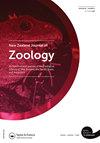新西兰信天翁在优势等级内觅食策略的变化
IF 1.1
4区 生物学
Q3 ZOOLOGY
引用次数: 0
摘要
本文章由计算机程序翻译,如有差异,请以英文原文为准。
Variation in foraging strategies of New Zealand albatross species within a dominance hierarchy
ABSTRACT Co-occurring species sharing a limited resource are thought to adopt alternative strategies to coexist. Here, we investigate four species of co-occurring albatrosses in southern New Zealand that share food resources but differ in dominance status to test for variation in strategies to acquire supplemental food provided by ecotourism boats. We found evidence for distinct foraging strategies consistent with each species’ dominance rank. Buller’s albatross (Thalassarche bulleri) was the most subordinate species and frequently pursued scraps of fish on the periphery of the feeding flocks and avoided interacting with other species. Salvin’s albatross (Thalassarche salvini) and White-capped albatross (Thalassarche cauta) were intermediate in dominance status; both had fast responses to fish and typically pursued the largest fish scraps, though T. cauta successfully stole fish while T. salvini did not. In contrast, Southern Royal albatross (Diomedea epomophora) was the dominant species and did not avoid interactions with other species and pursued the largest fish scraps but was slower to respond compared with some subordinates. Natural food sources approximate the scenarios seen behind ecotourism boats, suggesting that differences in foraging strategies are likely present without human intervention. Overall, our results suggest that foraging strategies associated with dominance hierarchies could help structure seabird communities.
求助全文
通过发布文献求助,成功后即可免费获取论文全文。
去求助
来源期刊
CiteScore
2.80
自引率
0.00%
发文量
20
审稿时长
>12 weeks
期刊介绍:
Aims: The diversity of the fauna of the southern continents and oceans is of worldwide interest to researchers in universities, museums, and other centres. The New Zealand Journal of Zoology plays an important role in disseminating information on field-based, experimental, and theoretical research on the zoology of the region.

 求助内容:
求助内容: 应助结果提醒方式:
应助结果提醒方式:


